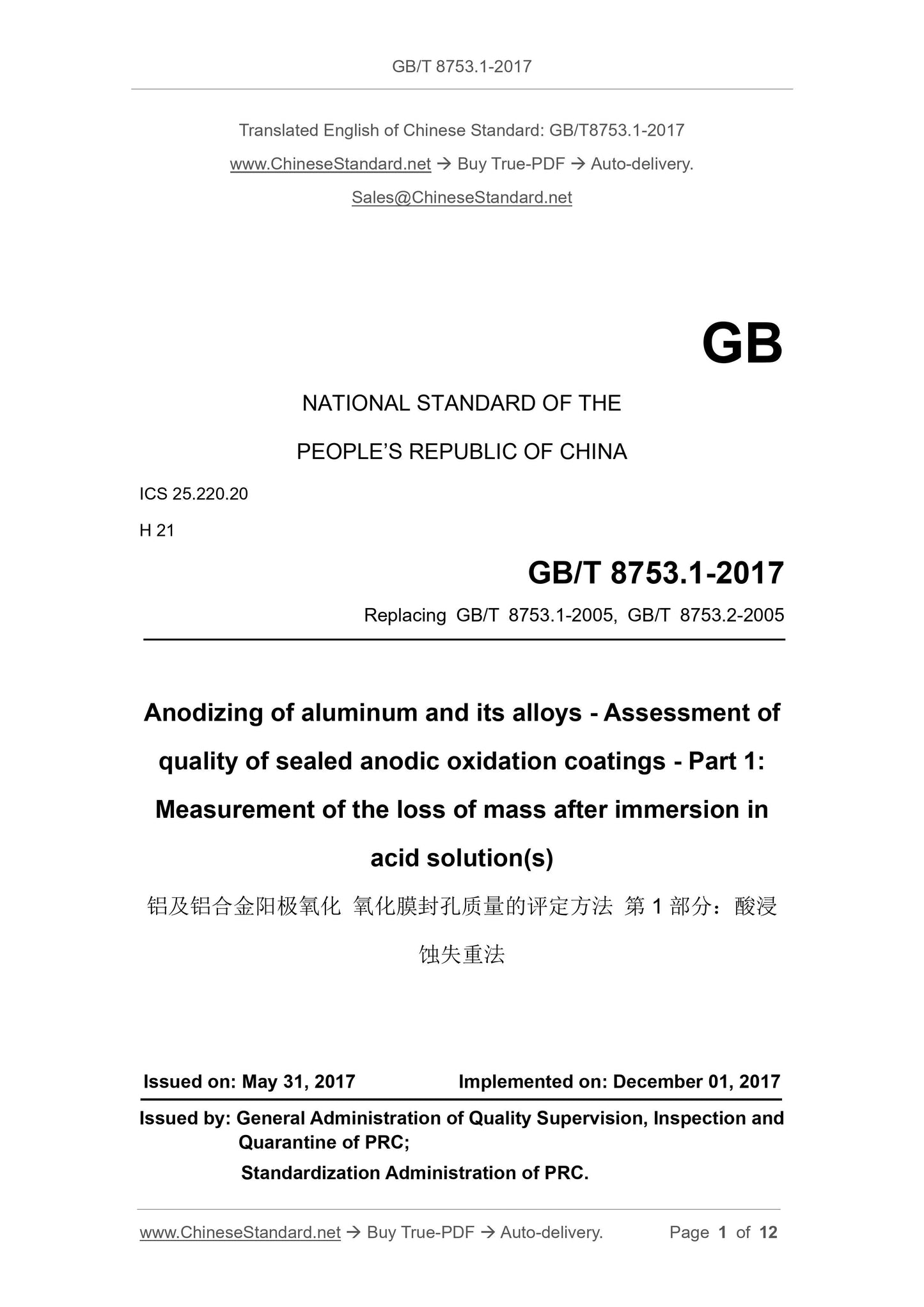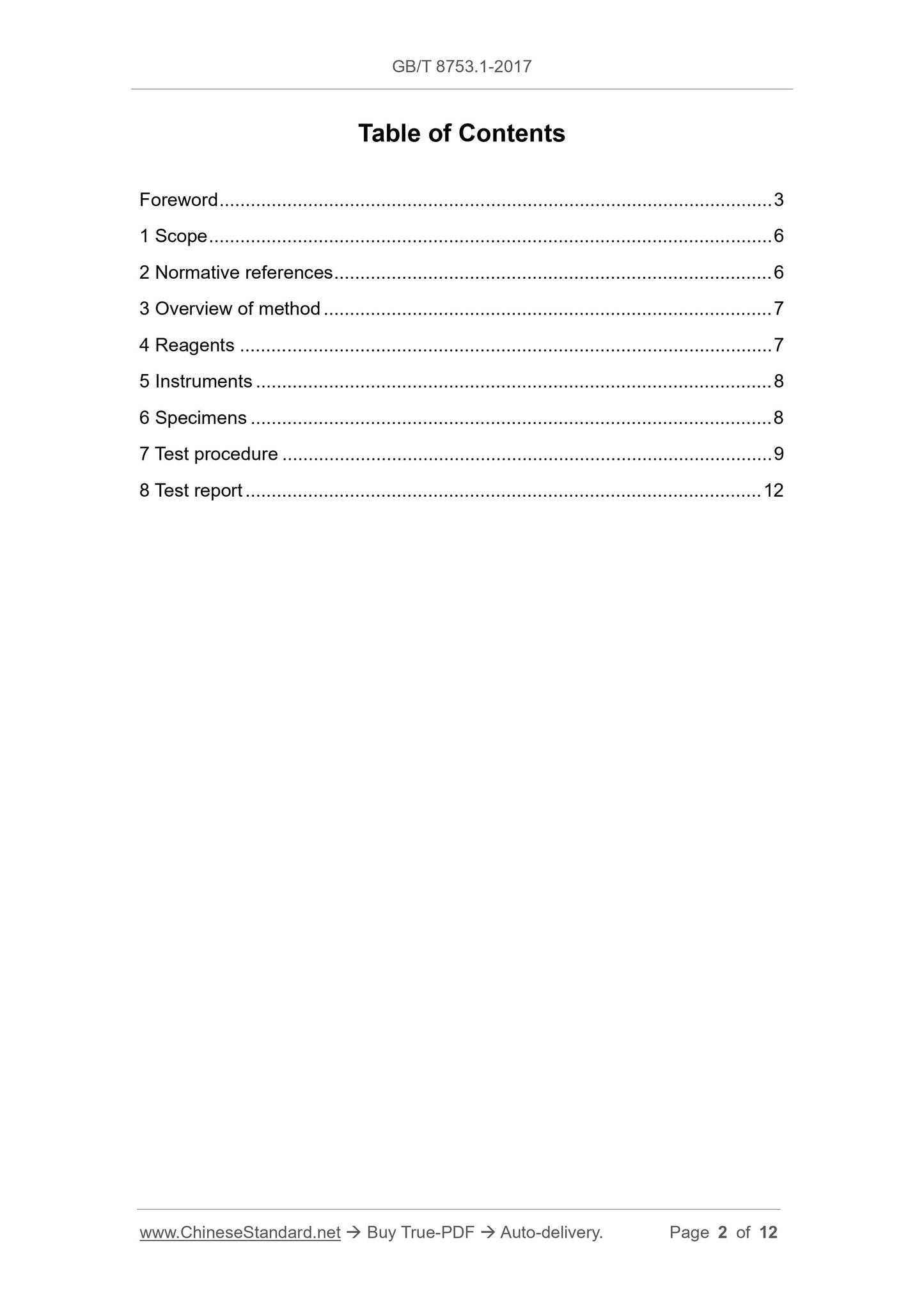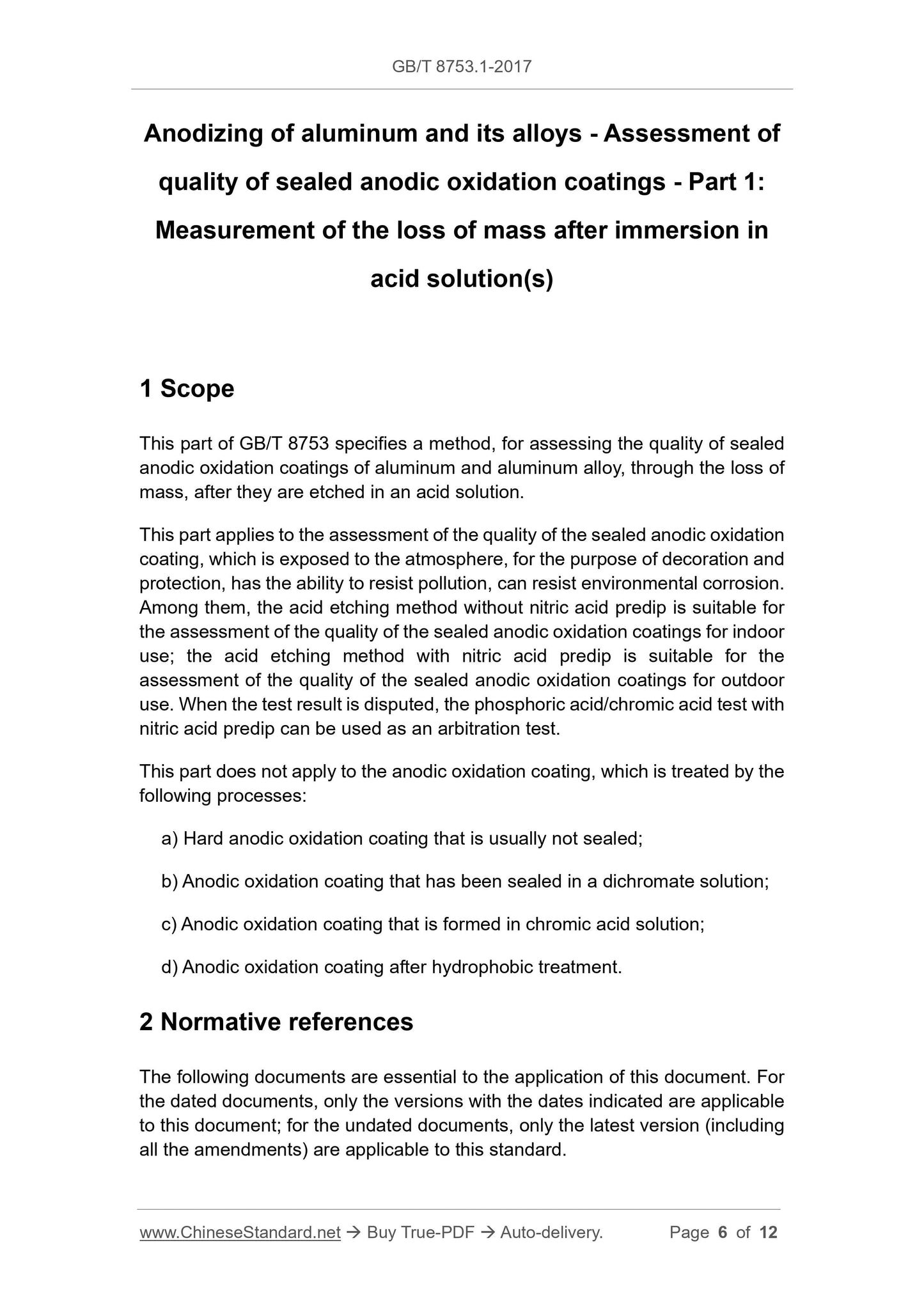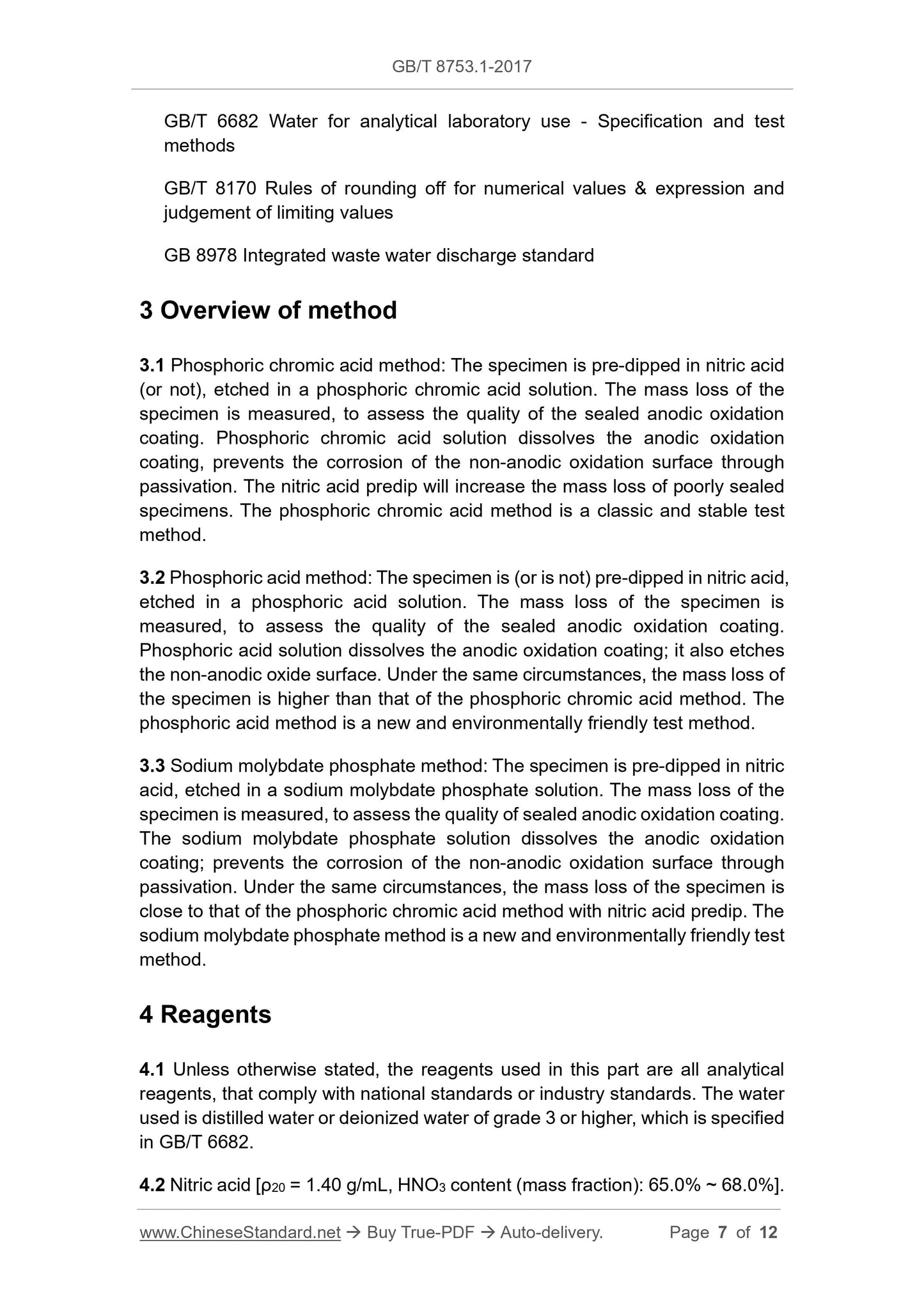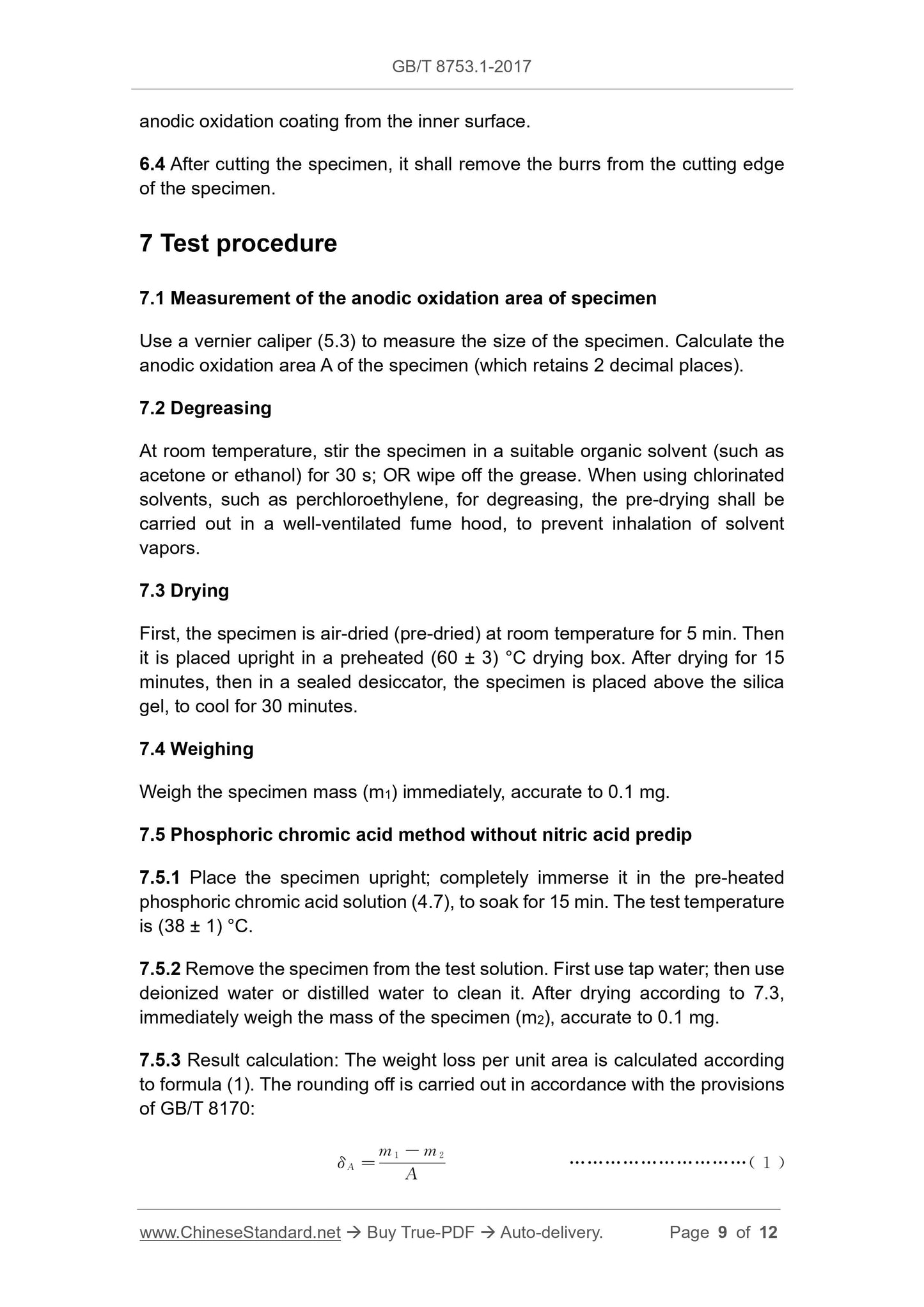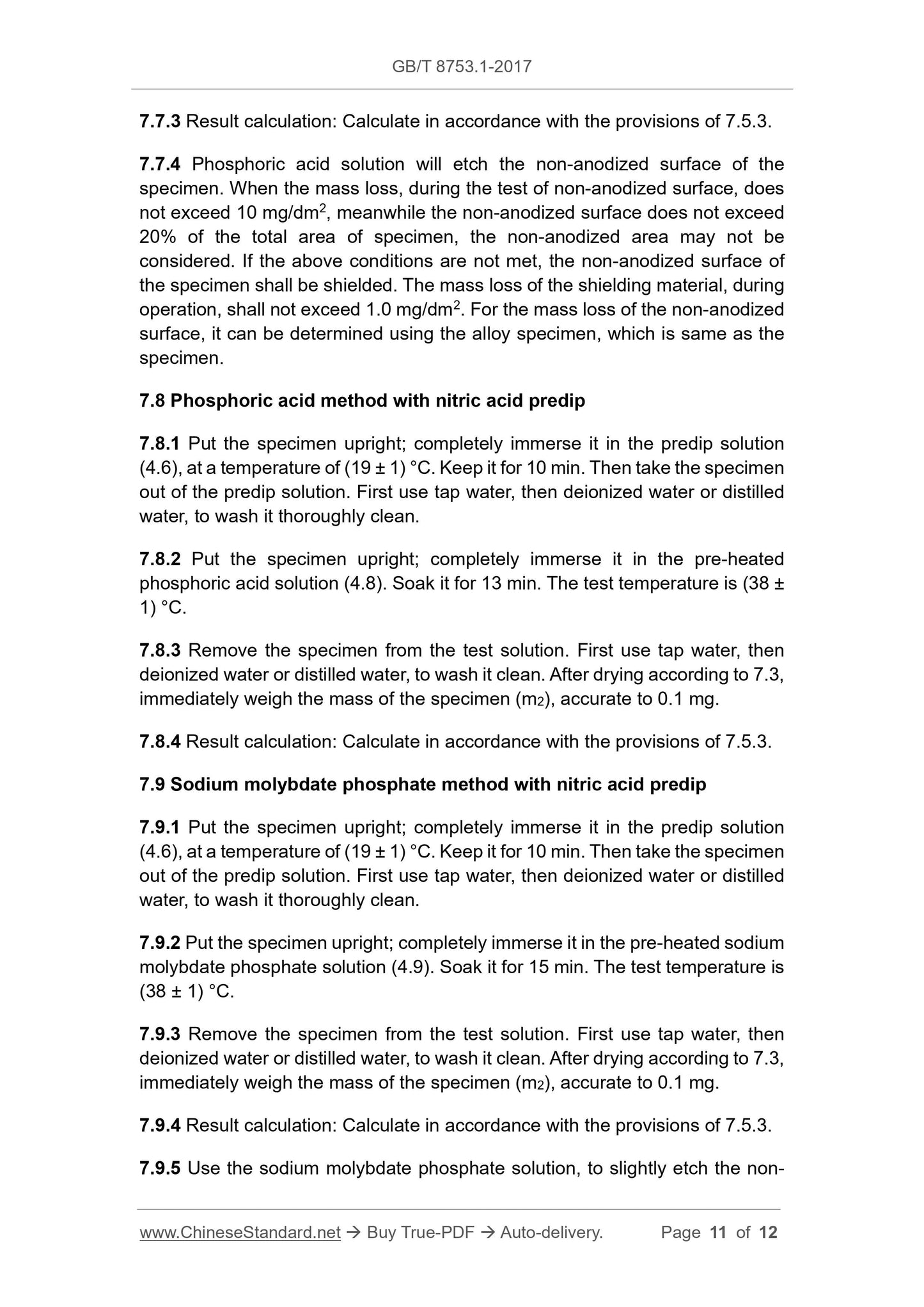1
/
of
6
www.ChineseStandard.us -- Field Test Asia Pte. Ltd.
GB/T 8753.1-2017 English PDF (GB/T8753.1-2017)
GB/T 8753.1-2017 English PDF (GB/T8753.1-2017)
Regular price
$110.00
Regular price
Sale price
$110.00
Unit price
/
per
Shipping calculated at checkout.
Couldn't load pickup availability
GB/T 8753.1-2017: Anodizing of aluminum and its alloys - Assessment of quality of sealed anodic oxidation coatings - Part 1: Measurement of the loss of mass after immersion in acid solution(s)
Delivery: 9 seconds. Download (& Email) true-PDF + Invoice.
Get Quotation: Click GB/T 8753.1-2017 (Self-service in 1-minute)
Historical versions (Master-website): GB/T 8753.1-2017
Preview True-PDF (Reload/Scroll-down if blank)
GB/T 8753.1-2017
GB
NATIONAL STANDARD OF THE
PEOPLE’S REPUBLIC OF CHINA
ICS 25.220.20
H 21
Replacing GB/T 8753.1-2005, GB/T 8753.2-2005
Anodizing of aluminum and its alloys - Assessment of
quality of sealed anodic oxidation coatings - Part 1:
Measurement of the loss of mass after immersion in
acid solution(s)
ISSUED ON: MAY 31, 2017
IMPLEMENTED ON: DECEMBER 01, 2017
Issued by: General Administration of Quality Supervision, Inspection and
Quarantine of PRC;
Standardization Administration of PRC.
Table of Contents
Foreword ... 3
1 Scope ... 6
2 Normative references ... 6
3 Overview of method ... 7
4 Reagents ... 7
5 Instruments ... 8
6 Specimens ... 8
7 Test procedure ... 9
8 Test report ... 12
Anodizing of aluminum and its alloys - Assessment of
quality of sealed anodic oxidation coatings - Part 1:
Measurement of the loss of mass after immersion in
acid solution(s)
1 Scope
This part of GB/T 8753 specifies a method, for assessing the quality of sealed
anodic oxidation coatings of aluminum and aluminum alloy, through the loss of
mass, after they are etched in an acid solution.
This part applies to the assessment of the quality of the sealed anodic oxidation
coating, which is exposed to the atmosphere, for the purpose of decoration and
protection, has the ability to resist pollution, can resist environmental corrosion.
Among them, the acid etching method without nitric acid predip is suitable for
the assessment of the quality of the sealed anodic oxidation coatings for indoor
use; the acid etching method with nitric acid predip is suitable for the
assessment of the quality of the sealed anodic oxidation coatings for outdoor
use. When the test result is disputed, the phosphoric acid/chromic acid test with
nitric acid predip can be used as an arbitration test.
This part does not apply to the anodic oxidation coating, which is treated by the
following processes:
a) Hard anodic oxidation coating that is usually not sealed;
b) Anodic oxidation coating that has been sealed in a dichromate solution;
c) Anodic oxidation coating that is formed in chromic acid solution;
d) Anodic oxidation coating after hydrophobic treatment.
2 Normative references
The following documents are essential to the application of this document. For
the dated documents, only the versions with the dates indicated are applicable
to this document; for the undated documents, only the latest version (including
all the amendments) are applicable to this standard.
GB/T 6682 Water for analytical laboratory use - Specification and test
methods
GB/T 8170 Rules of rounding off for numerical values and expression and
judgement of limiting values
GB 8978 Integrated waste water discharge standard
3 Overview of method
3.1 Phosphoric chromic acid method: The specimen is pre-dipped in nitric acid
(or not), etched in a phosphoric chromic acid solution. The mass loss of the
specimen is measured, to assess the quality of the sealed anodic oxidation
coating. Phosphoric chromic acid solution dissolves the anodic oxidation
coating, prevents the corrosion of the non-anodic oxidation surface through
passivation. The nitric acid predip will increase the mass loss of poorly sealed
specimens. The phosphoric chromic acid method is a classic and stable test
method.
3.2 Phosphoric acid method: The specimen is (or is not) pre-dipped in nitric acid,
etched in a phosphoric acid solution. The mass loss of the specimen is
measured, to assess the quality of the sealed anodic oxidation coating.
Phosphoric acid solution dissolves the anodic oxidation coating; it also etches
the non-anodic oxide surface. Under the same circumstances, the mass loss of
the specimen is higher than that of the phosphoric chromic acid method. The
phosphoric acid method is a new and environmentally friendly test method.
3.3 Sodium molybdate phosphate method: The specimen is pre-dipped in nitric
acid, etched in a sodium molybdate phosphate solution. The mass loss of the
specimen is measured, to assess the quality of sealed anodic oxidation coating.
The sodium molybdate phosphate solution dissolves the anodic oxidation
coating; prevents the corrosion of the non-anodic oxidation surface through
passivation. Under the same circumstances, the mass loss of the specimen is
close to that of the phosphoric chromic acid method with nitric acid predip. The
sodium molybdate phosphate method is a new and environmentally friendly test
method.
4 Reagents
4.1 Unless otherwise stated, the reagents used in this part are all analytical
reagents, that comply with national standards or industry standards. The water
used is distilled water or deionized water of grade 3 or higher, which is specified
in GB/T 6682.
4.2 Nitric acid [ρ20 = 1.40 g/mL, HNO3 content (mass fraction): 65.0% ~ 68.0%].
anodic oxidation coating from the inner surface.
6.4 After cutting the specimen, it shall remove the burrs from the cutting edge
of the specimen.
7 Test procedure
7.1 Measurement of the anodic oxidation area of specimen
Use a vernier caliper (5.3) to measure the size of the specimen. Calculate the
anodic oxidation area A of the specimen (which retains 2 decimal places).
7.2 Degreasing
At room temperature, stir the specimen in a suitable organic solvent (such as
acetone or ethanol) for 30 s; OR wipe off the grease. When using chlorinated
solvents, such as perchloroethylene, for degreasing, the pre-drying shall be
carried out in a well-ventilated fume hood, to prevent inhalation of solvent
vapors.
7.3 Drying
First, the specimen is air-dried (pre-dried) at room temperature for 5 min. Then
it is placed upright in a preheated (60 ± 3) °C drying box. After drying for 15
minutes, then in a sealed desiccator, the specimen is placed above the silica
gel, to cool for 30 minutes.
7.4 Weighing
Weigh the specimen mass (m1) immediately, accurate to 0.1 mg.
7.5 Phosphoric chromic acid method without nitric acid predip
7.5.1 Place the specimen upright; completely immerse it in the pre-heated
phosphoric chromic acid solution (4.7), to soak for 15 min. The test temperature
is (38 ± 1) °C.
7.5.2 Remove the specimen from the test solution. First use tap water; then use
deionized water or distilled water to clean it. After drying according to 7.3,
immediately weigh the mass of the specimen (m2), accurate to 0.1 mg.
7.5.3 Result calculation: The weight loss per unit area is calculated according
to formula (1). The rounding off is carried out in accordance with the provisions
of GB/T 8170:
7.7.3 Result calculation: Calculate in accordance with the provisions of 7.5.3.
7.7.4 Phosphoric acid solution will etch the non-anodized surface of the
specimen. When the mass loss, during the test of non-anodized surface, does
not exceed 10 mg/dm2, meanwhile the non-anodized surface does not exceed
20% of the total area of specimen, the non-anodized area may not be
considered. If the above conditions are not met, the non-anodized surface of
the specimen shall be shielded. The mass loss of the shielding material, during
operation, shall not exceed 1.0 mg/dm2. For the mass loss of the non-anodized
surface, it can be determined using the alloy specimen, which is same as the
specimen.
7.8 Phosphoric acid method with nitric acid predip
7.8.1 Put the specimen upright; completely immerse it in the predip solution
(4.6), at a temperature of (19 ± 1) °C. Keep it for 10 min. Then take the specimen
out of the predip solution. First use tap water, then deionized water or distilled
water, to wash it thoroughly clean.
7.8.2 Put the specimen upright; completely immerse it in the pre-heated
phosphoric acid solution (4.8). Soak it for 13 min. The test temperature is (38 ±
1) °C.
7.8.3 Remove the specimen from the test solution. First use tap water, then
deionized water or distilled water, to wash it clean. After drying according to 7.3,
immediately weigh the mass of the specimen (m2), accurate to 0.1 mg.
7.8.4 Result calculation: Calculate in accordance with the provisions of 7.5.3.
7.9 Sodium molybdate phosphate method with nitric acid predip
7.9.1 Put the specimen upright; completely immerse it in the predip solution
(4.6), at a temperature of (19 ± 1) °C. Keep it for 10 min. Then take the specimen
out of the predip solution. First use tap water, then deionized water or distilled
water, to wash it thoroughly clean.
7.9.2 Put the specimen upright; completely immerse it in the pre-heated sodium
molybdate phosphate solution (4.9). Soak it for 15 min. The test temperature is
(38 ± 1) °C.
7.9.3 Remove the specimen from the test solution. First use tap water, then
deionized water or distilled water, to wash it clean. After drying according to 7.3,
immediately weigh the mass of the specimen (m2), accurate to 0.1 mg.
7.9.4 Result calculation: Calculate in accordance with the provisions of 7.5.3.
7.9.5 Use the sodium molybdate phosphate solution, to slightly etch the non-
GB/T 8753.1-2017
GB
NATIONAL STANDARD OF THE
PEOPLE’S REPUBLIC OF CHINA
ICS 25.220.20
H 21
Replacing GB/T 8753.1-2005, GB/T 8753.2-2005
Anodizing of aluminum and its alloys - Assessment of
quality of sealed anodic oxidation coatings - Part 1:
Measurement of the loss of mass after immersion in
acid solution(s)
ISSUED ON: MAY 31, 2017
IMPLEMENTED ON: DECEMBER 01, 2017
Issued by: General Administration of Quality Supervision, Inspection and
Quarantine of PRC;
Standardization Administration of PRC.
Table of Contents
Foreword ... 3
1 Scope ... 6
2 Normative references ... 6
3 Overview of method ... 7
4 Reagents ... 7
5 Instruments ... 8
6 Specimens ... 8
7 Test procedure ... 9
8 Test report ... 12
Anodizing of aluminum and its alloys - Assessment of
quality of sealed anodic oxidation coatings - Part 1:
Measurement of the loss of mass after immersion in
acid solution(s)
1 Scope
This part of GB/T 8753 specifies a method, for assessing the quality of sealed
anodic oxidation coatings of aluminum and aluminum alloy, through the loss of
mass, after they are etched in an acid solution.
This part applies to the assessment of the quality of the sealed anodic oxidation
coating, which is exposed to the atmosphere, for the purpose of decoration and
protection, has the ability to resist pollution, can resist environmental corrosion.
Among them, the acid etching method without nitric acid predip is suitable for
the assessment of the quality of the sealed anodic oxidation coatings for indoor
use; the acid etching method with nitric acid predip is suitable for the
assessment of the quality of the sealed anodic oxidation coatings for outdoor
use. When the test result is disputed, the phosphoric acid/chromic acid test with
nitric acid predip can be used as an arbitration test.
This part does not apply to the anodic oxidation coating, which is treated by the
following processes:
a) Hard anodic oxidation coating that is usually not sealed;
b) Anodic oxidation coating that has been sealed in a dichromate solution;
c) Anodic oxidation coating that is formed in chromic acid solution;
d) Anodic oxidation coating after hydrophobic treatment.
2 Normative references
The following documents are essential to the application of this document. For
the dated documents, only the versions with the dates indicated are applicable
to this document; for the undated documents, only the latest version (including
all the amendments) are applicable to this standard.
GB/T 6682 Water for analytical laboratory use - Specification and test
methods
GB/T 8170 Rules of rounding off for numerical values and expression and
judgement of limiting values
GB 8978 Integrated waste water discharge standard
3 Overview of method
3.1 Phosphoric chromic acid method: The specimen is pre-dipped in nitric acid
(or not), etched in a phosphoric chromic acid solution. The mass loss of the
specimen is measured, to assess the quality of the sealed anodic oxidation
coating. Phosphoric chromic acid solution dissolves the anodic oxidation
coating, prevents the corrosion of the non-anodic oxidation surface through
passivation. The nitric acid predip will increase the mass loss of poorly sealed
specimens. The phosphoric chromic acid method is a classic and stable test
method.
3.2 Phosphoric acid method: The specimen is (or is not) pre-dipped in nitric acid,
etched in a phosphoric acid solution. The mass loss of the specimen is
measured, to assess the quality of the sealed anodic oxidation coating.
Phosphoric acid solution dissolves the anodic oxidation coating; it also etches
the non-anodic oxide surface. Under the same circumstances, the mass loss of
the specimen is higher than that of the phosphoric chromic acid method. The
phosphoric acid method is a new and environmentally friendly test method.
3.3 Sodium molybdate phosphate method: The specimen is pre-dipped in nitric
acid, etched in a sodium molybdate phosphate solution. The mass loss of the
specimen is measured, to assess the quality of sealed anodic oxidation coating.
The sodium molybdate phosphate solution dissolves the anodic oxidation
coating; prevents the corrosion of the non-anodic oxidation surface through
passivation. Under the same circumstances, the mass loss of the specimen is
close to that of the phosphoric chromic acid method with nitric acid predip. The
sodium molybdate phosphate method is a new and environmentally friendly test
method.
4 Reagents
4.1 Unless otherwise stated, the reagents used in this part are all analytical
reagents, that comply with national standards or industry standards. The water
used is distilled water or deionized water of grade 3 or higher, which is specified
in GB/T 6682.
4.2 Nitric acid [ρ20 = 1.40 g/mL, HNO3 content (mass fraction): 65.0% ~ 68.0%].
anodic oxidation coating from the inner surface.
6.4 After cutting the specimen, it shall remove the burrs from the cutting edge
of the specimen...
Delivery: 9 seconds. Download (& Email) true-PDF + Invoice.
Get Quotation: Click GB/T 8753.1-2017 (Self-service in 1-minute)
Historical versions (Master-website): GB/T 8753.1-2017
Preview True-PDF (Reload/Scroll-down if blank)
GB/T 8753.1-2017
GB
NATIONAL STANDARD OF THE
PEOPLE’S REPUBLIC OF CHINA
ICS 25.220.20
H 21
Replacing GB/T 8753.1-2005, GB/T 8753.2-2005
Anodizing of aluminum and its alloys - Assessment of
quality of sealed anodic oxidation coatings - Part 1:
Measurement of the loss of mass after immersion in
acid solution(s)
ISSUED ON: MAY 31, 2017
IMPLEMENTED ON: DECEMBER 01, 2017
Issued by: General Administration of Quality Supervision, Inspection and
Quarantine of PRC;
Standardization Administration of PRC.
Table of Contents
Foreword ... 3
1 Scope ... 6
2 Normative references ... 6
3 Overview of method ... 7
4 Reagents ... 7
5 Instruments ... 8
6 Specimens ... 8
7 Test procedure ... 9
8 Test report ... 12
Anodizing of aluminum and its alloys - Assessment of
quality of sealed anodic oxidation coatings - Part 1:
Measurement of the loss of mass after immersion in
acid solution(s)
1 Scope
This part of GB/T 8753 specifies a method, for assessing the quality of sealed
anodic oxidation coatings of aluminum and aluminum alloy, through the loss of
mass, after they are etched in an acid solution.
This part applies to the assessment of the quality of the sealed anodic oxidation
coating, which is exposed to the atmosphere, for the purpose of decoration and
protection, has the ability to resist pollution, can resist environmental corrosion.
Among them, the acid etching method without nitric acid predip is suitable for
the assessment of the quality of the sealed anodic oxidation coatings for indoor
use; the acid etching method with nitric acid predip is suitable for the
assessment of the quality of the sealed anodic oxidation coatings for outdoor
use. When the test result is disputed, the phosphoric acid/chromic acid test with
nitric acid predip can be used as an arbitration test.
This part does not apply to the anodic oxidation coating, which is treated by the
following processes:
a) Hard anodic oxidation coating that is usually not sealed;
b) Anodic oxidation coating that has been sealed in a dichromate solution;
c) Anodic oxidation coating that is formed in chromic acid solution;
d) Anodic oxidation coating after hydrophobic treatment.
2 Normative references
The following documents are essential to the application of this document. For
the dated documents, only the versions with the dates indicated are applicable
to this document; for the undated documents, only the latest version (including
all the amendments) are applicable to this standard.
GB/T 6682 Water for analytical laboratory use - Specification and test
methods
GB/T 8170 Rules of rounding off for numerical values and expression and
judgement of limiting values
GB 8978 Integrated waste water discharge standard
3 Overview of method
3.1 Phosphoric chromic acid method: The specimen is pre-dipped in nitric acid
(or not), etched in a phosphoric chromic acid solution. The mass loss of the
specimen is measured, to assess the quality of the sealed anodic oxidation
coating. Phosphoric chromic acid solution dissolves the anodic oxidation
coating, prevents the corrosion of the non-anodic oxidation surface through
passivation. The nitric acid predip will increase the mass loss of poorly sealed
specimens. The phosphoric chromic acid method is a classic and stable test
method.
3.2 Phosphoric acid method: The specimen is (or is not) pre-dipped in nitric acid,
etched in a phosphoric acid solution. The mass loss of the specimen is
measured, to assess the quality of the sealed anodic oxidation coating.
Phosphoric acid solution dissolves the anodic oxidation coating; it also etches
the non-anodic oxide surface. Under the same circumstances, the mass loss of
the specimen is higher than that of the phosphoric chromic acid method. The
phosphoric acid method is a new and environmentally friendly test method.
3.3 Sodium molybdate phosphate method: The specimen is pre-dipped in nitric
acid, etched in a sodium molybdate phosphate solution. The mass loss of the
specimen is measured, to assess the quality of sealed anodic oxidation coating.
The sodium molybdate phosphate solution dissolves the anodic oxidation
coating; prevents the corrosion of the non-anodic oxidation surface through
passivation. Under the same circumstances, the mass loss of the specimen is
close to that of the phosphoric chromic acid method with nitric acid predip. The
sodium molybdate phosphate method is a new and environmentally friendly test
method.
4 Reagents
4.1 Unless otherwise stated, the reagents used in this part are all analytical
reagents, that comply with national standards or industry standards. The water
used is distilled water or deionized water of grade 3 or higher, which is specified
in GB/T 6682.
4.2 Nitric acid [ρ20 = 1.40 g/mL, HNO3 content (mass fraction): 65.0% ~ 68.0%].
anodic oxidation coating from the inner surface.
6.4 After cutting the specimen, it shall remove the burrs from the cutting edge
of the specimen.
7 Test procedure
7.1 Measurement of the anodic oxidation area of specimen
Use a vernier caliper (5.3) to measure the size of the specimen. Calculate the
anodic oxidation area A of the specimen (which retains 2 decimal places).
7.2 Degreasing
At room temperature, stir the specimen in a suitable organic solvent (such as
acetone or ethanol) for 30 s; OR wipe off the grease. When using chlorinated
solvents, such as perchloroethylene, for degreasing, the pre-drying shall be
carried out in a well-ventilated fume hood, to prevent inhalation of solvent
vapors.
7.3 Drying
First, the specimen is air-dried (pre-dried) at room temperature for 5 min. Then
it is placed upright in a preheated (60 ± 3) °C drying box. After drying for 15
minutes, then in a sealed desiccator, the specimen is placed above the silica
gel, to cool for 30 minutes.
7.4 Weighing
Weigh the specimen mass (m1) immediately, accurate to 0.1 mg.
7.5 Phosphoric chromic acid method without nitric acid predip
7.5.1 Place the specimen upright; completely immerse it in the pre-heated
phosphoric chromic acid solution (4.7), to soak for 15 min. The test temperature
is (38 ± 1) °C.
7.5.2 Remove the specimen from the test solution. First use tap water; then use
deionized water or distilled water to clean it. After drying according to 7.3,
immediately weigh the mass of the specimen (m2), accurate to 0.1 mg.
7.5.3 Result calculation: The weight loss per unit area is calculated according
to formula (1). The rounding off is carried out in accordance with the provisions
of GB/T 8170:
7.7.3 Result calculation: Calculate in accordance with the provisions of 7.5.3.
7.7.4 Phosphoric acid solution will etch the non-anodized surface of the
specimen. When the mass loss, during the test of non-anodized surface, does
not exceed 10 mg/dm2, meanwhile the non-anodized surface does not exceed
20% of the total area of specimen, the non-anodized area may not be
considered. If the above conditions are not met, the non-anodized surface of
the specimen shall be shielded. The mass loss of the shielding material, during
operation, shall not exceed 1.0 mg/dm2. For the mass loss of the non-anodized
surface, it can be determined using the alloy specimen, which is same as the
specimen.
7.8 Phosphoric acid method with nitric acid predip
7.8.1 Put the specimen upright; completely immerse it in the predip solution
(4.6), at a temperature of (19 ± 1) °C. Keep it for 10 min. Then take the specimen
out of the predip solution. First use tap water, then deionized water or distilled
water, to wash it thoroughly clean.
7.8.2 Put the specimen upright; completely immerse it in the pre-heated
phosphoric acid solution (4.8). Soak it for 13 min. The test temperature is (38 ±
1) °C.
7.8.3 Remove the specimen from the test solution. First use tap water, then
deionized water or distilled water, to wash it clean. After drying according to 7.3,
immediately weigh the mass of the specimen (m2), accurate to 0.1 mg.
7.8.4 Result calculation: Calculate in accordance with the provisions of 7.5.3.
7.9 Sodium molybdate phosphate method with nitric acid predip
7.9.1 Put the specimen upright; completely immerse it in the predip solution
(4.6), at a temperature of (19 ± 1) °C. Keep it for 10 min. Then take the specimen
out of the predip solution. First use tap water, then deionized water or distilled
water, to wash it thoroughly clean.
7.9.2 Put the specimen upright; completely immerse it in the pre-heated sodium
molybdate phosphate solution (4.9). Soak it for 15 min. The test temperature is
(38 ± 1) °C.
7.9.3 Remove the specimen from the test solution. First use tap water, then
deionized water or distilled water, to wash it clean. After drying according to 7.3,
immediately weigh the mass of the specimen (m2), accurate to 0.1 mg.
7.9.4 Result calculation: Calculate in accordance with the provisions of 7.5.3.
7.9.5 Use the sodium molybdate phosphate solution, to slightly etch the non-
GB/T 8753.1-2017
GB
NATIONAL STANDARD OF THE
PEOPLE’S REPUBLIC OF CHINA
ICS 25.220.20
H 21
Replacing GB/T 8753.1-2005, GB/T 8753.2-2005
Anodizing of aluminum and its alloys - Assessment of
quality of sealed anodic oxidation coatings - Part 1:
Measurement of the loss of mass after immersion in
acid solution(s)
ISSUED ON: MAY 31, 2017
IMPLEMENTED ON: DECEMBER 01, 2017
Issued by: General Administration of Quality Supervision, Inspection and
Quarantine of PRC;
Standardization Administration of PRC.
Table of Contents
Foreword ... 3
1 Scope ... 6
2 Normative references ... 6
3 Overview of method ... 7
4 Reagents ... 7
5 Instruments ... 8
6 Specimens ... 8
7 Test procedure ... 9
8 Test report ... 12
Anodizing of aluminum and its alloys - Assessment of
quality of sealed anodic oxidation coatings - Part 1:
Measurement of the loss of mass after immersion in
acid solution(s)
1 Scope
This part of GB/T 8753 specifies a method, for assessing the quality of sealed
anodic oxidation coatings of aluminum and aluminum alloy, through the loss of
mass, after they are etched in an acid solution.
This part applies to the assessment of the quality of the sealed anodic oxidation
coating, which is exposed to the atmosphere, for the purpose of decoration and
protection, has the ability to resist pollution, can resist environmental corrosion.
Among them, the acid etching method without nitric acid predip is suitable for
the assessment of the quality of the sealed anodic oxidation coatings for indoor
use; the acid etching method with nitric acid predip is suitable for the
assessment of the quality of the sealed anodic oxidation coatings for outdoor
use. When the test result is disputed, the phosphoric acid/chromic acid test with
nitric acid predip can be used as an arbitration test.
This part does not apply to the anodic oxidation coating, which is treated by the
following processes:
a) Hard anodic oxidation coating that is usually not sealed;
b) Anodic oxidation coating that has been sealed in a dichromate solution;
c) Anodic oxidation coating that is formed in chromic acid solution;
d) Anodic oxidation coating after hydrophobic treatment.
2 Normative references
The following documents are essential to the application of this document. For
the dated documents, only the versions with the dates indicated are applicable
to this document; for the undated documents, only the latest version (including
all the amendments) are applicable to this standard.
GB/T 6682 Water for analytical laboratory use - Specification and test
methods
GB/T 8170 Rules of rounding off for numerical values and expression and
judgement of limiting values
GB 8978 Integrated waste water discharge standard
3 Overview of method
3.1 Phosphoric chromic acid method: The specimen is pre-dipped in nitric acid
(or not), etched in a phosphoric chromic acid solution. The mass loss of the
specimen is measured, to assess the quality of the sealed anodic oxidation
coating. Phosphoric chromic acid solution dissolves the anodic oxidation
coating, prevents the corrosion of the non-anodic oxidation surface through
passivation. The nitric acid predip will increase the mass loss of poorly sealed
specimens. The phosphoric chromic acid method is a classic and stable test
method.
3.2 Phosphoric acid method: The specimen is (or is not) pre-dipped in nitric acid,
etched in a phosphoric acid solution. The mass loss of the specimen is
measured, to assess the quality of the sealed anodic oxidation coating.
Phosphoric acid solution dissolves the anodic oxidation coating; it also etches
the non-anodic oxide surface. Under the same circumstances, the mass loss of
the specimen is higher than that of the phosphoric chromic acid method. The
phosphoric acid method is a new and environmentally friendly test method.
3.3 Sodium molybdate phosphate method: The specimen is pre-dipped in nitric
acid, etched in a sodium molybdate phosphate solution. The mass loss of the
specimen is measured, to assess the quality of sealed anodic oxidation coating.
The sodium molybdate phosphate solution dissolves the anodic oxidation
coating; prevents the corrosion of the non-anodic oxidation surface through
passivation. Under the same circumstances, the mass loss of the specimen is
close to that of the phosphoric chromic acid method with nitric acid predip. The
sodium molybdate phosphate method is a new and environmentally friendly test
method.
4 Reagents
4.1 Unless otherwise stated, the reagents used in this part are all analytical
reagents, that comply with national standards or industry standards. The water
used is distilled water or deionized water of grade 3 or higher, which is specified
in GB/T 6682.
4.2 Nitric acid [ρ20 = 1.40 g/mL, HNO3 content (mass fraction): 65.0% ~ 68.0%].
anodic oxidation coating from the inner surface.
6.4 After cutting the specimen, it shall remove the burrs from the cutting edge
of the specimen...
Share
